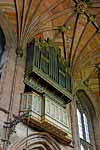Clumber Park St MaryOrgan
 The organ is mounted in a carved casework painted in gothic style green and gold and black with stencilled decor as ordered by Bodley in 1889 and fitted high in the panelled tribune above on the north-eastern side of the choir in the loft made of linen-fold re-grained and gilded panelling. The three manual instrument was built by Gray and Davidson of 870 Euston Road, London and Colquitt Street, Liverpool, at a cost of some £3,000, to a specification drawn up by Dr. Roberts, chapel organist at the Duke’s Magdalen College, Oxford. The casing is of oak with bone and ivory stops and ivory keys. An inscription in black Gothic script over the keyboard reads The organ is mounted in a carved casework painted in gothic style green and gold and black with stencilled decor as ordered by Bodley in 1889 and fitted high in the panelled tribune above on the north-eastern side of the choir in the loft made of linen-fold re-grained and gilded panelling. The three manual instrument was built by Gray and Davidson of 870 Euston Road, London and Colquitt Street, Liverpool, at a cost of some £3,000, to a specification drawn up by Dr. Roberts, chapel organist at the Duke’s Magdalen College, Oxford. The casing is of oak with bone and ivory stops and ivory keys. An inscription in black Gothic script over the keyboard reads
| Jesu tibi sit Gloria qui hatus es de virgine. Cum pater et almo spirita in sempiterua sorola. |
This was powered by a hand pumped bellows, which was later upgraded to a water-pump powered system.
The organist, Leslie Rupert Pike, from 1917, was responsible for music and all the minor repairs to the organ at the Chapel.
The quality of the sound was much affected by the varying changes in temperature in the chapel, owing to the erratic operation of the heating system at this time. The chapel was closed during 1936. Whilst Leslie Rupert Pike, the organist and estate choirmaster for some years made every endeavour to maintain the unit and the organ by executing any minor repairs himself, by late 1940, a greater refurbishment of the organ was required.
Whilst Pike had endeavoured to raise adequate funds, much more cash was required. Some sympathy to the plight was gathered and John Trayner, who lived at the Parsonage, set up a Chapel Committee as the National Trust’s agent for Clumber Park. Through his chairmanship, and the efforts of the Committee, more cash was directed to their common efforts, and, using expertise from the National Trust, the organ was again repaired and cleaned ready for the re-opening service held on May 25th 1952.
The instrument was extensively restored in 1979 by Messrs. Harrison and Harrison, and the painted panel front restored to its former glory by S.E. Dykes Bower. It will be observed however, when comparing with Brewer’s perspective drawing there is some difference to the end panel detail.
The pressurised air is provided, since the 1979 restoration, by an electrical Watkins and Watkins Ltd. blower unit developing 2.75 to 4 inches of mercury air-pressure.
At the opening in 1889, the duke’s organist, Mr George F. Ashley, shared the organ accompaniment with Dr. Roberts, who had spent some months in rehearsing the local choir for this first service. Unfortunately, when the house party was due to proceed to the Chapel a storm broke and the whole proceedings had to be delayed. Thus, Dr. Roberts was called on to supply considerably more music than he had planned for, to cover the interlude.
George Treadaway was for several years Clumber and the village of Hardwick’s talented schoolmaster who had responsibilities as their choirmaster and organist. He published in 1895 his ‘Vade-Mecum for church choirs’ and in time for Easter the following year the Clumber Hymnal, which brought together some 460 hymns, carols and litanies, for the Chapel’s High Anglican devotions, much no doubt to the delight of the Duke, his family and Father Hawkins, the 'high' priest in charge at that time.
There were continued debates on the high and low church attitudes towards the services, their ceremonial features, even the style and content of hymn books, which may have developed out of the parishioners visiting, by necessity, the other local churches at Bothamsall and Perlethorpe. Much upset was experienced when the ‘Clumber Hymnal’ was exchanged for ‘Hymns Ancient & Modern’ following the new edition being published in 1904.
These aggravations continued for many years, even the overly optimistic advice in 1931 from Major Kenneth Murray-Walker, Chief Agent of the estate to 'lean neither to the Presbyterian nor to Rome' had little effect.
| 








